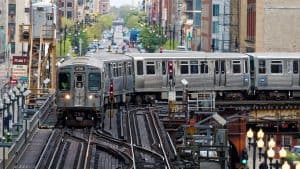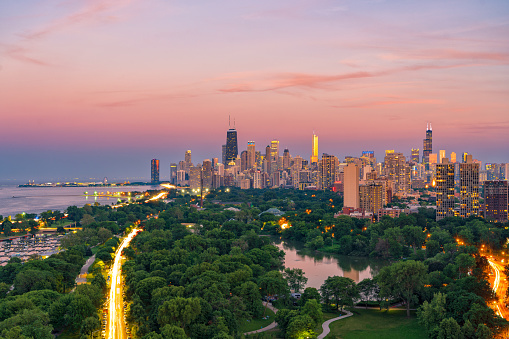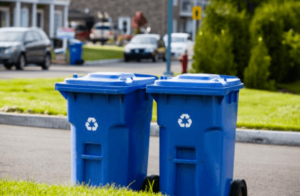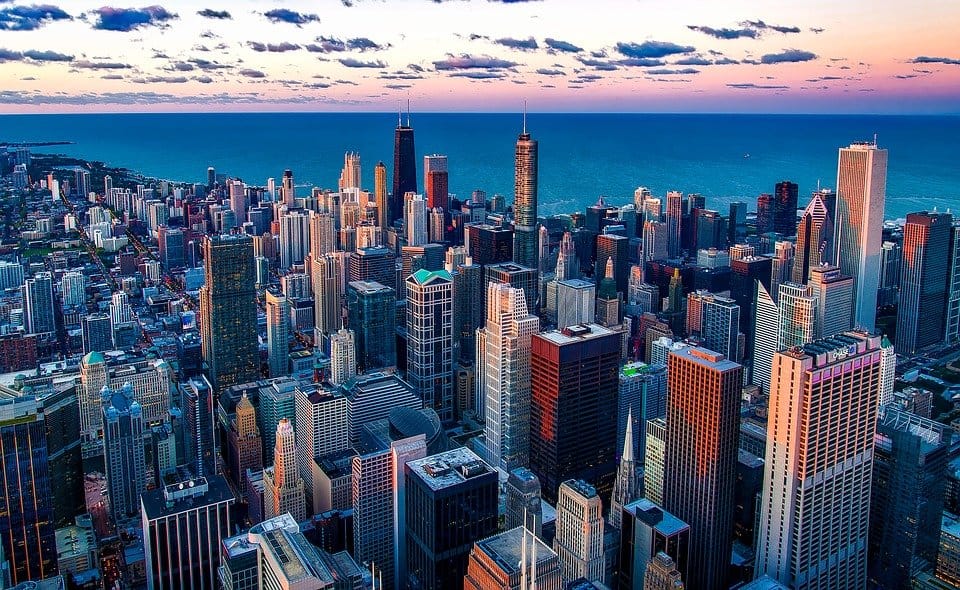Is Chicago a GREEN City?
Chicago might not be widely known as a green city, however, the city has a vast network of sustainable mass public transit options, a Sustainable Action Agenda, a high share of energy-efficient buildings, thousands of acres of land designated for natural, green spaces, and is home to a wide range of other green city initiatives.

CHICAGO IS - A Sustainable City
Chicago's Mass Transit & Green Spaces

Chicago has extensive sustainable mass public transportation networks.
Public mass transit options in Chicago include a large network of buses, Metra commuter rail lines, and 'L' railcar lines. The 'L' railcar lines are above-ground rapid transit railcars running on elevated subway routes, which combined make over 2,000 trips/ day on over 200 miles of track.
Chicago features 145 stations for its 8 'L' rapid transit rail lines, and over 120 bus routes with over 1800 buses with a combined ridership of around 500,000 per weekday. The Chicago Transit Authority (CTA) runs the 'L' rail lines and Chicago's bus service.
CTA's 'L' rail lines and CTA's bus lines are highly efficient, quick ways to get around the city, and run frequently throughout the day. CTA has been able to consistently lower its greenhouse gas emissions (GHGs), even while expanding.
CTA has a goal to use 100% clean energy by 2040 and has been able to cut its GHGs by over 10% annually. CTA has been able to maintain this GHG reduction, while growing its city fleet, by incorporating more energy-efficient transit options.
CTA plans on having an all-electric bus fleet by 2040.
Chicago not only features exemplary mass public transit networks but excels at maintaining green spaces in the city as well.
Chicago has benefited from substantial green urban planning.
The greater Chicago area consists of over 12,000 total acres of parkland (this includes land managed by the state and county - there are over 8,800 acres of green space owned by the Chicago Park District, including over 600 parks). ≈8.5% of the land area of Chicago is green space open to the public.
One great example of a large community park in Chicago is Lincoln Park, the city's largest park, at about 1200 acres. Lincoln Park is the adjacent home to a city district in Chicago's Northside (home to over 68,000 people), as well as the Lincoln Park Zoo.

The Sustainable Chicago Action Agenda

The City of Chicago has worked hard to put in motion plans to transform the city into one of the world’s brightest examples of a sustainable metropolis.
A path to this goal is found in the 7 themes of “The Sustainable Chicago Action Agenda”. These 7 themes include Chicago’s Climate Action Plan, Energy Efficiency & Clean Energy, Waste & Recycling, Waste & Wastewater, Transportation Options, Economic Development & Job Creation, and Parks & Open Space.
Chicago's citywide Climate Action Plan mirrors the goals of Chicago’s Sustainable Action Agenda. The Chicago Climate Action Plan includes climate change mitigation strategies featuring energy-efficient buildings, clean & renewable energy sources, improved transportation options, and reduced waste & industrial buildings.
Sustainability Action Agenda of the City of Chicago:
Focus on LEED buildings

One of the aspects of the Sustainability Action Agenda the City of Chicago has been most successful at implementing, and a major part of that which makes Chicago a sustainable city, from an energy use standpoint, is developing sustainable energy efficient buildings.
Another is the city’s implementation of sustainable technology with regard to retrofitting buildings.
LEED (Leadership in Energy and Environmental Design) certifies buildings that demonstrate excellence in the following categories: sustainable sites, location and transportation, water efficiency, energy and atmosphere, materials and resources, indoor environmental quality, and innovation in design.
Energy Star is another high energy efficiency standard for buildings and appliances within buildings, particularly high-efficiency electric appliances (such as electric HVAC units). Chicago excels at producing highly efficient buildings, and the electrification of buildings in order to enhance energy efficiency.
With regard to LEED and Energy Star buildings, Chicago has the highest percentage (at over 65%) of LEED-certified/ Energy Star-certified office buildings among the top 30 real estate markets in the United States.
The Willis Tower (pictured above) went from LEED Gold to Platinum certification in just one year through efficiency retrofitting. The Willis Tower, the tallest U.S. LEED Platinum building, has made significant energy, sustainability, and air quality/ healthy building environment improvements.
Retrofit Chicago

In order to make even more advancements in residential and business buildings’ energy and water efficiency, and reduce GHGs associated with buildings in the city, the City of Chicago has launched Retrofit Chicago -
"[Former] Mayor Rahm Emanuel has identified energy efficiency as a priority for strengthening Chicago— helping Chicago to be the most affordable, competitive, attractive, livable, and sustainable city of the 21st century.
Retrofit Chicago’s energy efficiency pursuits will help:
- Create Jobs
- Save Chicagoans money
- Reduce greenhouse gas emissions
- Demonstrate Chicago’s environmental leadership
The City of Chicago is making progress on implementing energy efficiency citywide."
[quote from - chicago.gov/retrofit_chicago]
Renewable Energy in Chicago
City buildings in Chicago are to be powered by 100% renewable energy by 2035 (per a resolution by the Chicago City Council). All Chicago Transit Authority buses are to run on electricity by 2040.
The city's (former) Mayor Rahm Emanuel, along with Chicago Public Schools, Chicago Housing Authority, Chicago Park District, and City Colleges of Chicago, had previously agreed to a 100% clean energy program for Chicago to be implemented over the next 2 decades.
This commitment makes Chicago the largest major city in the U.S. to commit to supplying all of its public buildings solely with renewable energy.
Sustainable Development Division of Chicago
The city of Chicago has initiated a Sustainable Development Division (SDD) to address sustainability concerns in the development of Chicago.
“... the Sustainable Development Division is responsible for creating and expanding public open space systems and developing policies and programs to advance the sustainability of the City's buildings, businesses and urban form. Long-term initiatives include waterfront access improvements, the expansion of natural habitats, improvements to the environmental performance of development sites, and the promotion of urban agriculture and other aspects of the local food system."
[quote from - chicago.gov/sustain]

Additionally, Chicago has created the Solar Express renewable energy initiative largely to advance green buildings in the city. The Chicago Solar Express is a public-private initiative to bring low-cost solar panels to the rooftops of Chicago - by cutting fees and streamlining permitting and zoning processes.
Since 2012, the City of Chicago and ComEd have worked with private partners and the University of Illinois, under a grant from the DOE’s Sunshot Initiative, to lower cost barriers and reduce market prices of purchasing and installing solar PV for the city.
"By committing the energy used to power our public buildings to wind and solar energy, we are sending a clear signal that we remain committed to building a 21st-century economy here in Chicago," [former] Mayor Emanuel said. The city of Chicago will achieve that commitment in a number of ways, including on-site generation and the acquisition of renewable energy credits (mostly wind and solar energy).
Jack Darin, president of the Illinois Sierra Club supports the effort, "...by moving boldly to re-power its public buildings with renewable energy like wind and solar, Chicago is leading by example at a time when local leadership is more important than ever.”
[quote from - goodnewsnetwork.org/chicago-city-buildings-powered-100-renewable-energy]
These efforts of Chicago in green building illustrate the success of Chicago Sustainability themes - substantially developing energy-efficient buildings, and retrofitting buildings in Chicago to be LEED and Energy Star certified. Chicago Solar Express, as well as the widespread development of electricity & renewable energy to power buildings throughout Chicago, illustrates more Sustainability themes - clean energy & energy efficiency.
Waste Management is yet another Sustainability theme in which the city of Chicago excels.
Chicago's Waste Management
The City of Chicago has developed ambitious recycling programs throughout the city. By reducing Chicago’s waste and implementing various recycling programs, the city of Chicago is making an effort to conserve resources, reduce greenhouse gas emissions associated with waste management, lower Chicago's carbon footprint, and reduce space in areas surrounding Chicago currently needed as landfills.
These are some of the programs offered by the city of Chicago to increase conservation in the city, especially focusing on Chicago’s recycling programs:
 - Blue Cart Recycling – “The City's Blue Cart program provides bi-weekly recycling services to single-family homes and multi-unit buildings. By recycling regularly, [residents of Chicago] can help reduce the need for landfills, lower disposal costs, reduce pollution, and conserve natural resources, such as timber and water.” [quote from - 311.chicago.gov/Blue-cart-residential-recycling-program]. Blue Cart Recycling includes almost every type of household waste and had diverted over a half-ton of waste from landfills in the first 10 months of 2018 alone.
- Blue Cart Recycling – “The City's Blue Cart program provides bi-weekly recycling services to single-family homes and multi-unit buildings. By recycling regularly, [residents of Chicago] can help reduce the need for landfills, lower disposal costs, reduce pollution, and conserve natural resources, such as timber and water.” [quote from - 311.chicago.gov/Blue-cart-residential-recycling-program]. Blue Cart Recycling includes almost every type of household waste and had diverted over a half-ton of waste from landfills in the first 10 months of 2018 alone.
- recycling drop-off centers, a household chemicals recycling center, and a computer recycling facility
- construction and demolition debris recycling - an ordinance requires that contractors recycle at least 50% of the recyclable debris generated by construction/ demolition
- Chicago Public Schools Recycling program
Another key sustainability initiative that is helping Chicago save money and resources is the city’s wastewater management program. New wastewater treatments are assisting in the recovery of essential energy, solids, and water. These resources are then recycled and transformed into assets that can generate revenue for the city, and protect the environment.
Green Infrastructure in Chicago, and Chicago's Greencorp
The city has also installed 50,000 water meters through the MeterSave program, to help residents of Chicago conserve water and reduce water bills. The city has made a $50 million investment to clean and upgrade 4,400 miles of sewer lines, while also upgrading the built infrastructure, creating a cleaner, greener infrastructure.
The City of Chicago is also investing in replacing and enhancing rooftops and roadways in the city to allow for stormwater to circulate back into the environment.
Chicago plans to continue to replace or build new clean green and clean infrastructure. The city is replacing sewer mains in order to control stormwater accumulation in the sewers. Sitting next to Lake Michigan and atop a swampy marshy land, water management is crucial for Chicago to become a more sustainable and resilient city.
With a history of water pollution and toxic city water, Chicago became one of the lead innovators of waste and water management by securing federal funding in 1970 to upgrade its treatment facilities as a result of the Clean Water Act. Chicago continues to lead by example while reducing its water usage and increasing its efficiency.
Chicago is also keenly focused on developing sustainability training and jobs among the inner-city population- namely through its flagship program, Greencorps Chicago.
Greencorps Chicago provides training and jobs in environmental conservation, as well as nature-area management careers, to Chicago residents with barriers to employment. The Greencorps Chicago Youth Program, which launched in 2013, provides paid, sustainability-focused summer jobs.
CTA
In addition to robust citywide conservation and waste management programs, the city of Chicago also has well-developed sustainable mass transit systems.
Chicago’s mass transit options include transportation offerings from the United States’ 2nd largest public mass transit system; run by the Chicago Transit Authority, which operates bus and rail lines in the city, including 145 rail stations for the 'L' rapid transit rail lines and over 120 bus routes.
The city of Chicago is on the way to becoming a leader in sustainable transit. Chicago Transit Authority is committed to providing integral transit options that are greener and more sustainable. CTA is a huge contributor to the city’s sustainability movement because it helps to reduce vehicle emissions by replacing automobile trips with mass transit, reduces traffic congestion, and enables compact development.
The city of Chicago has 1,500 railcars with electric high-efficiency rails, and the new "L" cars are a new family of railcars equipped with innovative braking systems that can transfer electricity back to the third rail, which supplements power to nearby CTA trains (among other advances in the design and function of the railcars).
The City of Chicago has launched a significant sustainable mass transportation campaign in order to reduce GHGs, decrease transit costs for the city and its residents, and increase efficiencies associated with transit. Chicago has 1,900 energy-efficient buses that were converted to ultra-low sulfur diesel engines in March 2003; since 2007 any new buses acquired have been equipped with clean diesel or hybrid-electric engines. The city of Chicago plans to purchase additional all-electric buses and eventually (by 2040) have all its buses run on electricity.
Chicago has also made an effort to promote its multimodal transportation. That includes its Bike & Ride program. This program was established to improve bicycle access to bus routes and rail stations. In order to do that, the City of Chicago helped develop 6,000 Divvy bikes (Divvy bikes are part of a bike-sharing system run by the City of Chicago Department of Transportation), available for rent at 580 stations across the city.
CTA has also worked with car-sharing companies to make for easier access between public transit and car-sharing. The CTA’s multimodal integration addresses transit-friendly development by working with the City of Chicago and other municipalities to connect their services and destinations.

The way you discussed the topic with ease and completeness is really amazing. Thanks for this article!